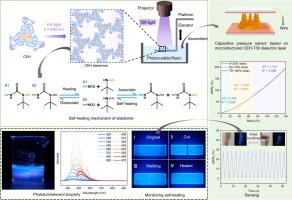用于 3D 打印制造柔性传感器的自愈合光致发光弹性体
IF 13.3
1区 工程技术
Q1 ENGINEERING, CHEMICAL
引用次数: 0
摘要
由于光致发光材料在化学传感、生物检测和光电设备中的广泛应用,近来引起了人们的极大兴趣。然而,现有的光致发光 3D 打印材料在机械性能、耐久性和稳定性方面存在缺陷,无法适应复杂结构或应力变化应用的 3D 打印,同时也影响了设备的长期稳定性。为了解决这些局限性,本研究开发了一种含有动态受阻脲键的光致发光自愈合弹性体,显示出优异的拉伸性能(560 %)、高强度(4.25 兆帕)和良好的自愈合能力(95.45 % 愈合效率)。这种弹性体还具有独特的光致发光特性,在发生明显变形时发光强度会发生变化。光致发光特性在 3D 打印弹性体中依然存在。此外,这种弹性体还可用于三维打印复杂结构和定制传感器,打印出的传感器能够实现分段响应。用这种材料制备的电阻式传感器具有高灵敏度和良好的周期稳定性,能够检测人体的各种运动,同时通过发光强度的变化提供额外的感官信息。这项研究为开发光致发光自修复材料的多功能应用(包括智能可穿戴设备、动态显示和光学传感器)提供了新的见解。本文章由计算机程序翻译,如有差异,请以英文原文为准。

Self-healing, photoluminescent elastomers for 3D printing fabrication of flexible sensors
Photoluminescent materials have garnered a lot of interest lately because of their many uses in chemical sensing, bio-detection, and optoelectronic devices. However, existing photoluminescent 3D printing materials exhibit deficiencies in mechanical properties, durability, and stability, hindering their adaptation to 3D printing of complex structures or stress-varying applications, while compromising the long-term stability of devices. To address these limitations, a photoluminescent self-healing elastomers containing dynamically hindered urea bonds were developed in this study, demonstrating excellent tensile properties (560 %), high strength (4.25 MPa), and good self-healing capabilities (95.45 % healing efficiency). The elastomer also exhibits unique photoluminescent characteristics, with luminous intensity varying under significant deformations. Photoluminescent characteristics are still present in 3D printed elastomers. Moreover, the elastomers can be utilized for 3D printing complex structures and customized sensors, with the printed sensors capable of achieving segmented responses. Resistive sensors prepared from this material exhibit high sensitivity and good cyclic stability, and they are capable of detecting various human motions while providing additional sensory information through changes in luminescent intensity. This study offers new insights into the development of photoluminescent self-healing materials for multifunctional applications, including smart wearable devices, dynamic displays, and optical sensors.
求助全文
通过发布文献求助,成功后即可免费获取论文全文。
去求助
来源期刊

Chemical Engineering Journal
工程技术-工程:化工
CiteScore
21.70
自引率
9.30%
发文量
6781
审稿时长
2.4 months
期刊介绍:
The Chemical Engineering Journal is an international research journal that invites contributions of original and novel fundamental research. It aims to provide an international platform for presenting original fundamental research, interpretative reviews, and discussions on new developments in chemical engineering. The journal welcomes papers that describe novel theory and its practical application, as well as those that demonstrate the transfer of techniques from other disciplines. It also welcomes reports on carefully conducted experimental work that is soundly interpreted. The main focus of the journal is on original and rigorous research results that have broad significance. The Catalysis section within the Chemical Engineering Journal focuses specifically on Experimental and Theoretical studies in the fields of heterogeneous catalysis, molecular catalysis, and biocatalysis. These studies have industrial impact on various sectors such as chemicals, energy, materials, foods, healthcare, and environmental protection.
 求助内容:
求助内容: 应助结果提醒方式:
应助结果提醒方式:


